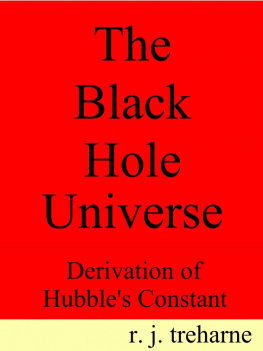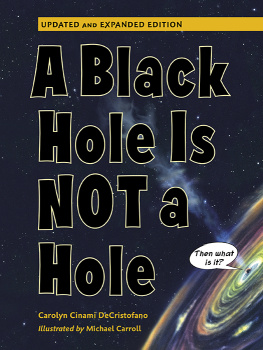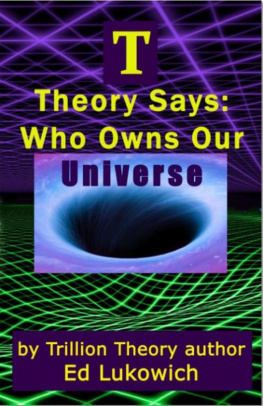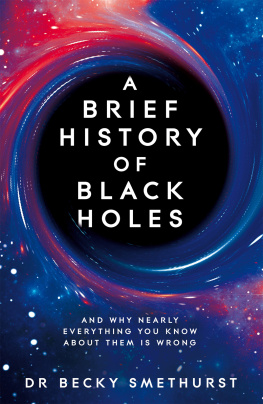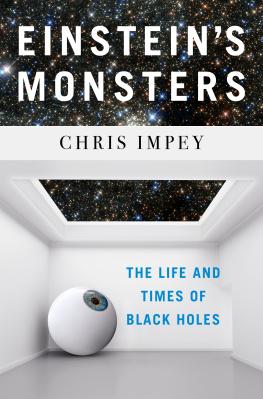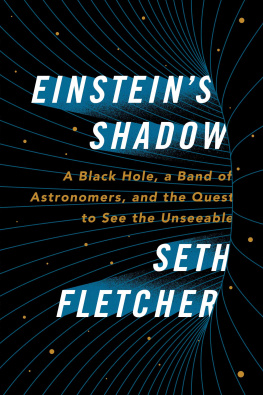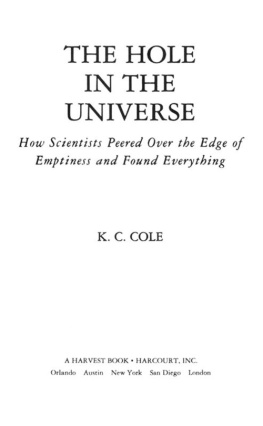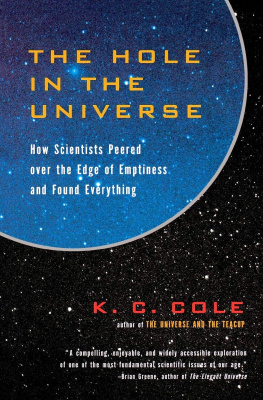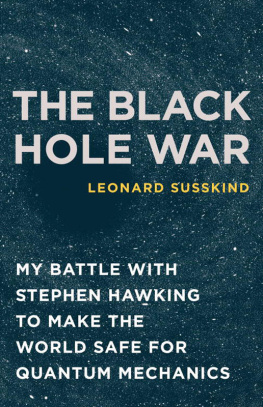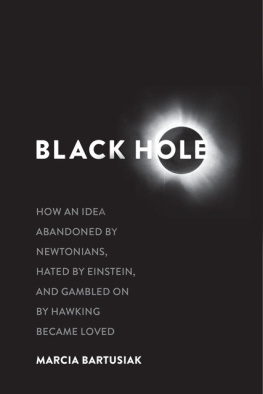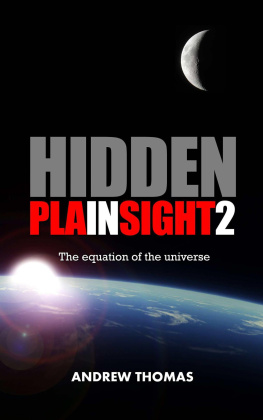Treharne - The black hole universe
Here you can read online Treharne - The black hole universe full text of the book (entire story) in english for free. Download pdf and epub, get meaning, cover and reviews about this ebook. genre: Art. Description of the work, (preface) as well as reviews are available. Best literature library LitArk.com created for fans of good reading and offers a wide selection of genres:
Romance novel
Science fiction
Adventure
Detective
Science
History
Home and family
Prose
Art
Politics
Computer
Non-fiction
Religion
Business
Children
Humor
Choose a favorite category and find really read worthwhile books. Enjoy immersion in the world of imagination, feel the emotions of the characters or learn something new for yourself, make an fascinating discovery.
The black hole universe: summary, description and annotation
We offer to read an annotation, description, summary or preface (depends on what the author of the book "The black hole universe" wrote himself). If you haven't found the necessary information about the book — write in the comments, we will try to find it.
The black hole universe — read online for free the complete book (whole text) full work
Below is the text of the book, divided by pages. System saving the place of the last page read, allows you to conveniently read the book "The black hole universe" online for free, without having to search again every time where you left off. Put a bookmark, and you can go to the page where you finished reading at any time.
Font size:
Interval:
Bookmark:
By R. J. Treharne
Published by R.J. Treharne atSmashwords
Copyright 2016 R.J. Treharne
ISBN: 9781310437090
Smashwords Edition, LicenseNotes
This ebook is licensed for yourpersonal enjoyment only. This ebook may not be re-sold to otherpeople. If you would like to share this book with another person,please purchase an additional copy for each recipient. If yourereading this book and did not purchase it, or it was purchased foryour use only, then please return to Smashwords.com and purchaseyour own copy to help the author. Thank you for respecting the hardwork of this author.
Some BasicPhysics
For those of you who are cosmologicallychallenged or have physics phobia, this short book is written at alevel that should be comfortable for most people. So before delvinginto demonstrating how the universe can be thought of as a largeblack hole some basic physics may help the background. Most of usknow that atoms are comprised of electrons, protons and neutrons;three of the 12 known basic components of matter. The electron hasa negative electrical charge, the proton a positive electricalcharge, and the neutron, as it name suggests, is neutral or has noelectrical charge; which is one of the reasons why the neutron wasthe last of the three to be discovered. Like charges repeal eachother; for example, protons repeal other protons. Unlike chargesattract. Neutrons, however, have neither mutual repulsion norattraction. The specific number of the protons (and matching numberof electrons) within in atom determine the element and itsassociated chemical properties. Hydrogen has one proton, Helium twoprotons, Lithium 3 protons and so forth up to Uranium which as 92protons.
An atom is comprised of a small core ornucleus at its center usually comprised of both protons andneutrons (the exception being the lonely hydrogen atom which onlyhas a single proton). The neutrons usually are equal to or close innumber to the number of protons within the nucleus, and are whathelp overcome the protons repulsive forces, holding the protonstogether. Around this proton and neutron nucleus is a cloud ofelectrons (the number of electrons being equal to the number ofprotons). The term cloud is used because the electrons are notlike small planets orbiting around a sun, but are more or less likestatistical possibilities of an electron existing everywhere andnowhere at the same time. Yes, a very unsettling idea welcome toworld of quantum mechanics.
A neutron is essentially a proton(positive charge) combined with an electron (negative charge). Theproton is about 1,836 times more massive than an electron; aneutron, about 1,837 times as massive. Consequently, the bulk ofthe mass of an atom is concentrated in the nucleus. Relative to thesize of the nucleus, the cloud of electrons is massive; somethinglike the Oort cloud of comets orbiting our own Sun. From thevantage point of the Oort cloud, at the far edge of our solarsystem, the Sun is but a dim point of light not much brighter thanmost other stars. There is a lot of empty space between theplanets, asteroids and comets orbiting the Sun. Likewise in an atomthere is a small volume of mass, the nucleus, surrounded by a verylarge volume of very little mass, the electrons. An atom is mostlynothing but empty space.
When a sun undergoesthermonuclear reaction it basically combine atoms with a fewprotons and neutrons into larger atoms containing the combinednumber of protons and neutrons into a single atom, a process calledfusion. In the process a very small amount of the mass is convertedinto energy (E=mc stuff). The fusion occurs due to the enormousamount of pressure and temperature created by the relentless mutualgravitational attraction when a very large number of atoms (mass)are clumped together. It takes quantity of atoms greater than themass of Jupiter, but less than our Sun, to achieve the criticalmass threshold to cause the temperature and pressure needed toinduce thermonuclear fusion. The larger the collection of atoms(mass), the stronger the gravity and thus the greater thetemperature and pressure. The more massive the star the higher theatomic number (number of protons in an atom) it can fuse togetherto create new elements. Our Sun, for example, is only massiveenough to fuse hydrogen into the next heavier element, helium. Moremassive stars can fuse together heavier elements up to iron (atomicnumber 26) which is relatively common in the universe (for a heavyelement) and very stable. Beyond that, though, it takes a differentprocess of stellar evolution, a stellar explosion of very massivestars (a supernova) to produce the heavier natural elements, up toUranium (atomic number 92).
The structure of an atom is verystrong, retaining its configuration even when two of them areforced together to fuse into a new heavier element. But if thetemperatures and pressures get high enough, such as a result at thecenter of a supernova explosion, even the structure of the atomcannot hold itself together and the electrons are forced into thenucleus and bind with the protons, The result: nothing but neutronsare left a neutron star is born. A neutron star could have thesame mass of our Sun (which is about 1.4 million kilometers indiameter), yet only be a few kilometers across. Neutron stars areso dense that a teaspoon amount would weigh millions of kilograms;really dense stuff. A neutron star could be bright, but probablynot as bright as the Sun, since it is only glowing because of itsown heat and not because of nuclear fusion. If our Sun was replacedwith an equivalent mass neutron star, the planets would still orbitas they do, held in orbit by its gravity.
Neutron stars, as inconceivably denseas they are, are still not the limits of possible compression ofmass in a collapsed star. Even neutrons can only withstand so muchpressure and temperature. Combine enough mass together and even theneutron structure will yield to the extreme pressure andtemperature. When a neutron yields it identity, it collapses intoGod only knows literally. Even physicists only speculate as towhat really happens. All they really know is that all the mass isstill there, and consequently so is all the gravity, but it existsin an even smaller volume of space. So much of the collapse of anneutron star is unknown that what happens next is simply referredto as a black hole a point in space (and time) that yieldsridiculous conditions where the laws of normal physics as we knowthem seem to break down. Gravity is so intense near the blackholes surface and the gravity is so strong (that is the space isso warped) that nothing, not even a fleeting light particle thephoton, can escape its gravitational pull. Which is one of the manyreasons it is called a black hole, because if you could see it,there would be no light coming from it; hence it should be black.No one really knows for sure since no black hole has been seendirectly. The point from the surface of a black hole where thelight can no longer escape the pull of gravity is referred to asthe event horizon which is even larger than the black holeitself. What is occurring at the event horizon or within the eventhorizon is the subject of many debates among cosmologicalphysicists. Perhaps black holes themselves have different stages ofdevelopment. For example, once the pressures break down theneutrons in a neutron star, the next collapse could be into aquark star a stellar body comprised of nothing but thefundamental particles of neutrons themselves, quarks. And maybe, asthe black holes mass continues to increase, even the internalstructure of quarks themselves collapse into perhaps whatever thefundamental structure of quarks are, and then once again to nothingbut pure compressed energy. No one really knows. We dont even knowif the inside of a black hole is even uniform, homogeneous or evenblack. What is inside a black hole is a big, bigquestion.
Font size:
Interval:
Bookmark:
Similar books «The black hole universe»
Look at similar books to The black hole universe. We have selected literature similar in name and meaning in the hope of providing readers with more options to find new, interesting, not yet read works.
Discussion, reviews of the book The black hole universe and just readers' own opinions. Leave your comments, write what you think about the work, its meaning or the main characters. Specify what exactly you liked and what you didn't like, and why you think so.

